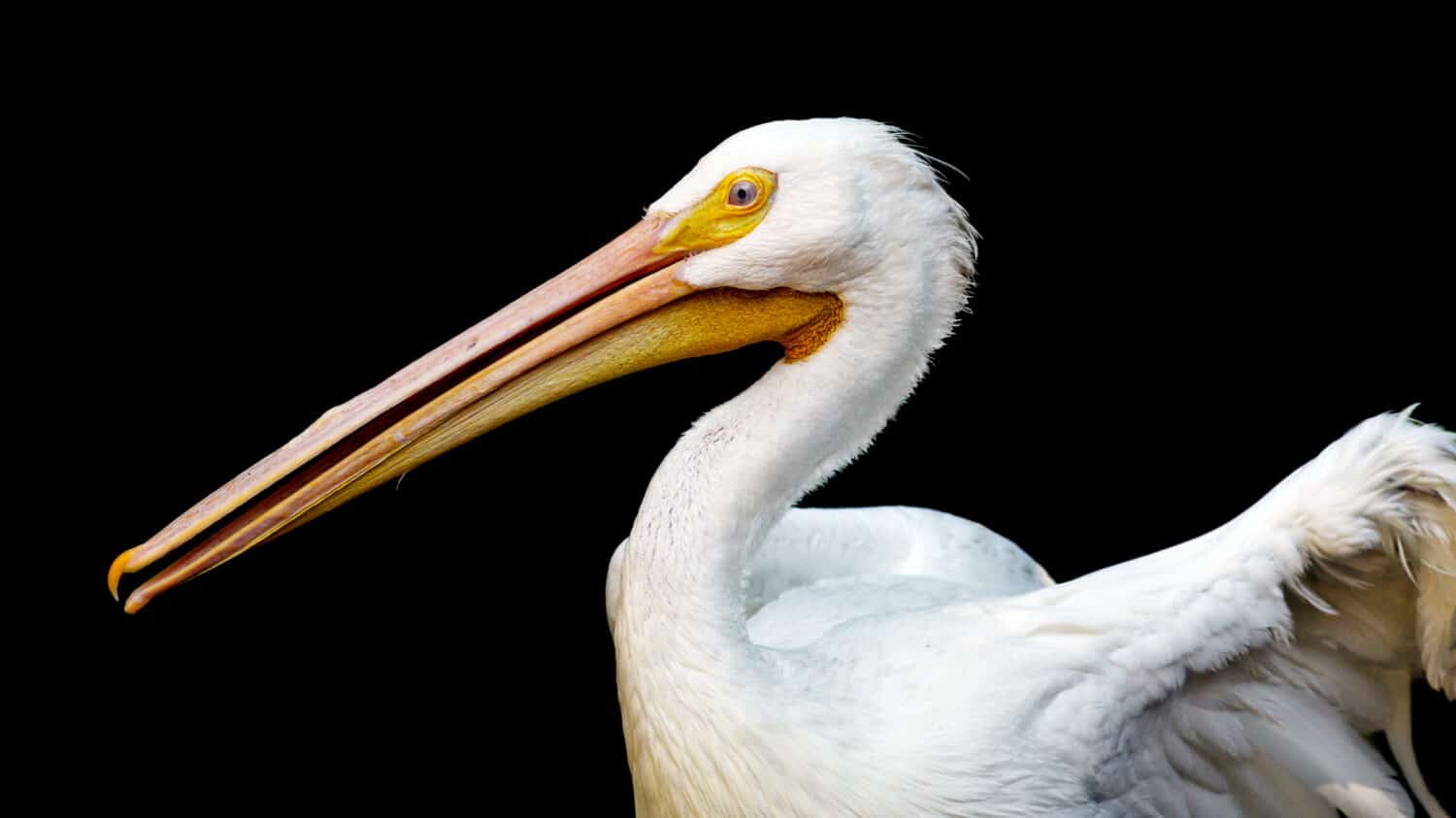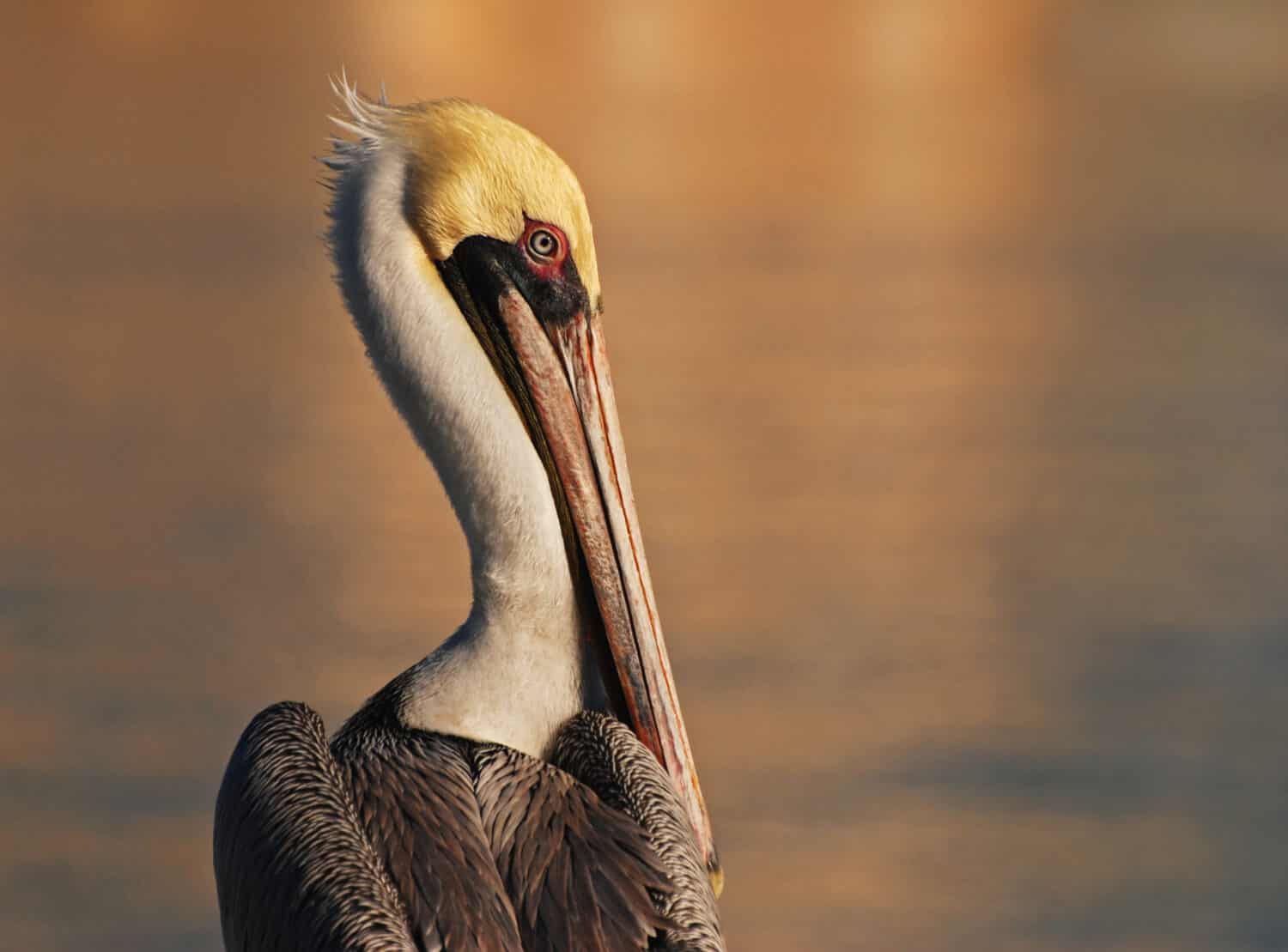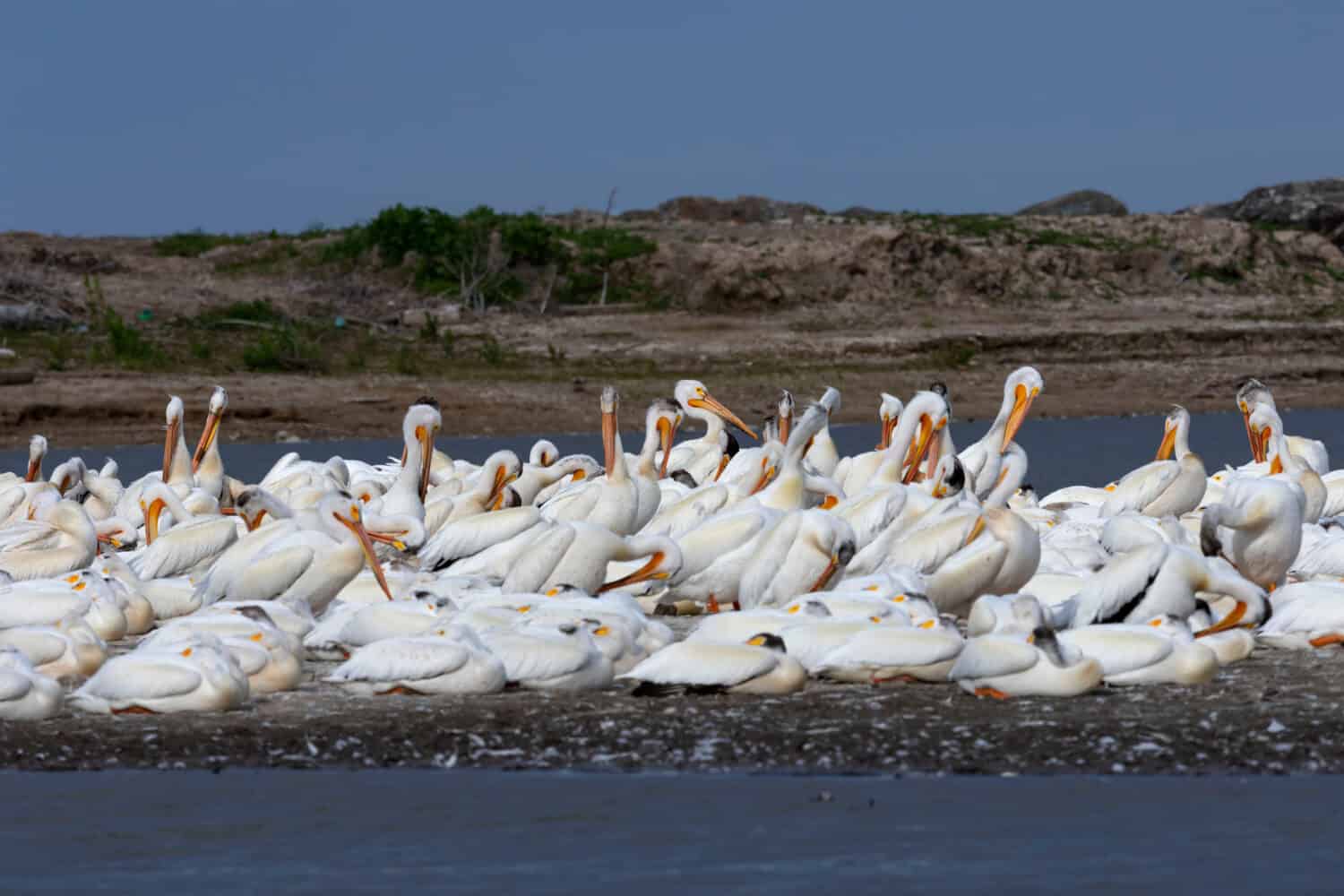Pelicans are intriguing and unique birds. They capture our attention and curiosity with their distinct beak and pouch, graceful flight, and engaging behaviors. Nestled within the vibrant ecosystem of the United States, they stand as remarkable symbols of the country’s avian biodiversity. One common question with many birds, including this bird, is where do pelicans nest?
From their intricate nesting habits to their migratory patterns, pelicans paint an intriguing picture of adaptation and survival. Understanding their role within their ecosystems, their habits, and the threats they face allows us to appreciate their importance and the need for their conservation. So let’s delve into the world of pelicans and explore the nesting habits of these captivating creatures.

The American White Pelican is one of two pelicans found in the United States.
©Patrick Rolands/Shutterstock.com
The Different Species of Pelicans
Across the landscapes of the United States and the globe, several unique pelican subspecies captivate birdwatchers and nature enthusiasts with their splendid plumage, huge beaks, and elaborate nesting rituals. There are eight pelican species worldwide, with two primarily found in the United States. These include the American White Pelican (Pelecanus erythrorhynchos) and the Brown Pelican (Pelecanus occidentalis).
Pelican Species Found in the United States
These pelican species are spread across diverse geographical locations, offering a visual treat for birdwatchers and an invaluable resource for scientists. The American White Pelican is a familiar sight in North America’s freshwater bodies. In contrast, the Brown Pelican primarily frequents coastal waters with its distinctive dark body and white neck.
Pelican Species Found Around the World
The remaining six species of pelicans include the Pink-backed Pelican, Great White Pelican, Dalmatian Pelican, Spot-billed Pelican, Australian Pelican, and Peruvian Pelican. All of which you can spot across the globe, from Africa, Europe, and Asia to Australia and South America. Each species showcases distinct traits in its coloration, size, or geographical preferences.
Nesting Behavior Varies Across the Different Species of Pelicans
Contrary to popular belief, not all pelicans nest in the same way. Nesting behavior varies depending on the species and their geographical location. The American White Pelican, for instance, often nests near bodies of water and typically establishes large colonies on islands in freshwater lakes. They construct rudimentary nests on the ground using vegetation, sticks, and debris. Brown Pelicans, on the other hand, choose coastal cliffs, mangroves, or islets to lay their eggs and use similar materials to build their nests. Still, they add a certain degree of complexity by creating intricate nest structures in trees or on rocky cliffs.
Similarly, other species of pelicans also present different nesting behaviors. The Australian Pelican, noted for being one of the largest flying birds, often prefers to nest in areas that are free of any vegetation, typically on islands or shores of inland waters. The Dalmatian Pelican, the world’s largest pelican species, builds its nests preferably on floating vegetation platforms in extensive wetlands across Eurasia.
When viewing pelicans, they possess a fascinating kaleidoscope of diverse species and behaviors. While there are eight distinct species globally, two primary ones call the United States home. They differ in appearance and geographical distribution and exhibit unique nesting habits shaped by their environment and evolutionary needs.

The Brown Pelican is found in the United States.
©michael d skelton/Shutterstock.com
Pelican Nesting Habits
Among the large water birds that grace the American skies and waters, the Brown Pelican and the American White Pelican are two species that command a special place. Their distinct nesting habits, marked by a preference for safe and secluded spaces, reflect their adaptability to the varied landscapes of the United States.
Brown Pelican Nesting Habits
The Brown Pelican, known for its dramatic, near-vertical dives for fish, is a fixture along the southern and western United States coasts. Brown Pelicans don’t just choose any location when it’s time to nest. They seek islands that offer security from land-based predators, allowing them to focus on raising their young. The type of island matters, too. Islands with dense vegetation like mangroves and shrubs offer much-needed cover and shade from the sun’s relentless rays and act as a windbreak during stormy weather.
Brown Pelicans are also proficient tree-nesters. They’re known to build their nests in trees such as red mangroves (Rhizophora mangle) and black mangroves (Avicennia germinans). Even shrubs like the Buttonwood (Conocarpus erectus) aren’t off the cards. These arboreal nests can be anywhere from 3 to 12 meters off the ground, providing added protection from ground-dwelling predators. These nests are constructed from plant materials, including sticks, leaves, and grass, forming a simple platform to cradle their eggs.
American White Pelican Nesting Habits
Heading inland, the American White Pelican makes its presence known around the lakes, marshes, and, occasionally, rivers of the United States. While they share the Brown Pelican’s affinity for island nesting, the similarity ends there. American White Pelicans opt for remote islands within freshwater bodies, far removed from human activity and terrestrial predators. They go for simplicity in nest construction, creating shallow depressions in the ground. These depressions are sometimes lined with a modest layer of vegetation, stones, or feathers.
Commonalities and Differences Between the Two
What’s common between these two American species of pelicans is their strategic choice of nesting locations – islands that offer safety and minimal disturbance. However, they also exhibit distinct behaviors shaped by their environmental needs and habitats. Brown Pelicans, coastal and marine in nature, nest on vegetation-dense islands or trees, while the American White Pelicans, lovers of the inland freshwaters, opt for bare-ground nesting on secluded islands.
Their nesting habits demonstrate the remarkable versatility and adaptability of these iconic birds. The distinct preferences and behaviors observed across species offer a captivating glimpse into how these birds have evolved and adapted to the unique demands of their environments.

Brown Pelicans build arboreal nests that can be anywhere from 3 to 12 meters off the ground
©Bonnie Taylor Barry/Shutterstock.com
When Are Pelicans Most Active During the Day and Throughout the Year?
Pelicans in the United States are a thrilling spectacle for birdwatchers, nature enthusiasts, and casual observers alike. These magnificent birds are renowned for their large bills and pouches. Their behavioral patterns and seasonal activities are as fascinating as their physical attributes.
Daily Activity Habits
One of the most endearing qualities of the pelican is its active lifestyle. You’ll typically see pelicans in action during the day or diurnal hours. They venture out to fish, socialize, and partake in their daily activities in this timeframe.
Brown Pelicans, fondly associated with the coastal regions of the United States, are particularly active during low tide. Low tides expose shallow waters and tidal pools, making it easier for these birds to catch their fishy meals. Their fishing technique is a spectacle in itself. From heights of up to 60 feet, Brown Pelicans execute near-vertical dives into the water. Skillfully scooping up fish in their large bill pouches.
In contrast, the American White Pelican, commonly found in freshwater environments across the central and western United States, has a different fishing strategy. Rather than solitary dives, they work cooperatively to herd fish towards the shallows before scooping them into their bill pouches. This communal foraging behavior typically happens during the day, offering a captivating sight for anyone lucky enough to witness it.
Pelicans in the United States are Migratory Birds
As for the question of when you can see pelicans throughout the year, the answer lies in their migratory patterns. The Brown Pelican and the American White Pelican are migratory species, but their migratory paths and timing differ.
Brown Pelicans, mainly found along the coastline, generally migrate shorter distances. During the winter, they move from the northern parts of their range, such as California and the Gulf Coast, towards warmer southern regions like Florida and Mexico. Their nesting season, usually from March through August, is the best time to see them in the northern parts of their range.
On the other hand, the American White Pelican undertakes more extensive migrations. They breed in inland North America during the spring and summer. They breed around bodies of water in regions such as the northern United States and Canada. As winter sets in, they embark on a journey south to the coastal regions of central and southern California, the Gulf of Mexico, and Florida.
If you want to witness these magnificent birds in action you have options. Your best bet would be to visit the coastlines during winter for Brown Pelicans. Or the inland lakes and marshes during spring and summer for American White Pelicans.
In sum, pelicans lead fascinating lives that oscillate with the rhythm of the day and the seasons. Their active lifestyles and migratory behaviors offer an excellent opportunity to observe nature in motion. As well as learn about the intriguing life cycle of these splendid birds.

American White Pelicans nest in large colonies, often on remote islands within freshwater bodies. Their nests consist of shallow depressions in the ground lined with a modest layer of vegetation, stones, or feathers.
©Karel Bock/Shutterstock.com
Which U.S. States Have the Most Pelicans?
In the United States, the majestic silhouette of pelicans in flight is a captivating sight. Whether it’s the elegant glide of the American White Pelican or the daring, near-vertical dive of the Brown Pelican, the pelican population paints a striking picture of avian diversity. Now, suppose you are interested in catching a glimpse of these magnificent birds. In that case, some states stand out as hotspots of pelican activity.
Florida
Among the coastal states, Florida is a prime destination for pelican enthusiasts. The state’s extensive coastline, diverse ecosystems, and warm climate make it an attractive spot for both American White Pelicans and Brown Pelicans. The latter is a permanent resident along the coast, seen in virtually every coastal county of Florida. While not a permanent resident, the American White Pelican visits the state during the winter months. Escaping the colder climates of its breeding grounds in the northern parts of the United States.
California
Heading west, California is another state where both species of pelicans found in the United States make a regular appearance. The coastline of California is a favored nesting ground for the Brown Pelican. Particularly the Channel Islands off the Southern California coast. The state also hosts a significant population of American White Pelicans during winter, particularly in the central and southern regions.
North Dakota
However, the states with the most variety of pelicans aren’t limited to the coastal regions. Inland states like North Dakota and Minnesota, with their abundance of freshwater bodies, provide ideal habitats for the American White Pelican. For instance, Chase Lake in North Dakota is home to American White Pelicans’ largest known nesting colony. This colony supports more than 30,000 breeding pairs.
Minnesota
Meanwhile, Minnesota, known as the Land of 10,000 Lakes, offers an extensive network of freshwater bodies for American White Pelicans during the breeding season. The state’s Marsh Lake is one of North America’s most significant pelican nesting sites. While primarily a haven for American White Pelicans, Minnesota occasionally sees Brown Pelicans that have strayed from their usual coastal habitats.
Texas
Lastly, Texas has an expansive coast along the Gulf of Mexico and abundant inland water bodies. It provides a hospitable environment for both pelican species. The American White Pelican winters along the coast and the state’s southern lakes. Meanwhile, the Brown Pelican is a year-round resident of the coastal areas.
Overall, states like Florida, California, North Dakota, Minnesota, and Texas are noteworthy for their rich pelican populations. The diverse habitats these states provide, from the sunny coastal regions to the serene freshwater bodies, offer a haven for American White Pelicans and Brown Pelicans. A visit to any of these states at the right time of the year promises a delightful encounter with these remarkable birds.

American White Pelicans are mostly found inland across the United States.
©Bonnie Taylor Barry/Shutterstock.com
The Importance of Pelicans in the Ecosystem
From the Brown Pelican’s coastal haunts to the American White Pelican’s freshwater retreats, these birds play crucial roles within their ecosystems. They function as key indicators of environmental health and biodiversity.
One of the primary roles pelicans play in the ecosystem is as a predator. Their preferred diet mainly consists of fish, but they consume crustaceans and occasionally smaller birds. This dietary preference places them within the middle of the food web, controlling the population of their prey, which could have drastic effects if left unchecked. For instance, by consuming a significant amount of rough fish like carp and suckers, the American White Pelican aids in maintaining a balanced aquatic ecosystem, thereby allowing game fish populations to thrive.
Moreover, pelicans, particularly American White Pelicans, are known for their cooperative fishing behavior. This behavior includes herding fish into shallow waters before engaging in a synchronized, collective scoop. This method enhances their fishing success and may create opportunities for other fish-eating species, enhancing overall biodiversity.
Beyond their role as predators, pelicans are also a food source for larger predators and scavengers. The eggs and chicks of pelicans serve as a significant food source for predators. Such predators include gulls, ravens, and foxes, highlighting their importance in the broader food chain.
Pelicans are also valuable bioindicators, signaling the health of the ecosystems they inhabit. Changes in pelican populations can provide early warning signs of problems within their environments. For instance, the decline in Brown Pelican populations in the mid-20th century was one of the first signs of the detrimental impact of the pesticide DDT. This led to its eventual ban in the United States.
Conservation of Pelicans
Given their ecological significance, protecting pelicans is of paramount importance. Conservation efforts for these species have been substantial and ongoing. Particularly so in light of habitat loss, pollution, and climate change challenges.
The Brown Pelican is a remarkable success story in conservation. Once teetering on the brink of extinction due to DDT-related eggshell thinning, the Brown Pelican has rebounded significantly following the ban on DDT in 1972. This achievement led to its removal from the Endangered Species List in 2009.
Still, the work is far from over. Conservation efforts continue to focus on preserving and managing pelican habitats, monitoring populations, and reducing human disturbances. For instance, in California, nesting sites are protected, and disturbance is minimized during the breeding season. In Florida, authorities conduct educational campaigns to discourage the public from feeding pelicans. Feeding them can harm their health and disrupt their natural behavior.
For American White Pelicans, the focus has been on protecting their breeding colonies, which are few and localized. Chase Lake in North Dakota, one of their largest colonies, is a National Wildlife Refuge where they implemented measures to protect these birds and their habitats.
In summary, pelicans serve as critical links within their ecosystems, contributing to biodiversity, maintaining balance, and signaling environmental health. Their preservation, facilitated by ongoing conservation efforts, is not just about saving a single species. It is also about preserving the intricate, interconnected web of life in which they play a vital role.

Brown Pelicans are primarily found on the coasts of the United States.
©Darryl Brooks/Shutterstock.com
Conclusion
In conclusion, pelicans’ nesting habits offer a fascinating glimpse into their behaviors and preferences. Illuminating how they interact with the environment. In the United States, pelicans establish their nests in diverse locations. American White Pelicans form ground colonies on remote islands in freshwater bodies. Whereas Brown Pelicans primarily nest in trees along the coastlines. These specific nesting behaviors are essential to their survival strategy and reproductive success. Nevertheless, these habits also highlight their vulnerability, particularly habitat loss and human disturbance. As such, conservation efforts to protect these critical nesting habitats are vital. By preserving these spaces and minimizing disturbances, we can support these remarkable birds in their annual cycle of reproduction and contribute to the ongoing health of our ecosystems.
The photo featured at the top of this post is © michael d skelton/Shutterstock.com
Thank you for reading! Have some feedback for us? Contact the AZ Animals editorial team.






